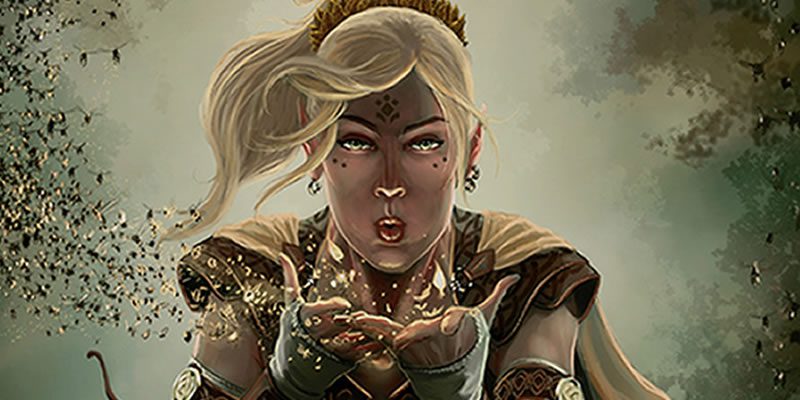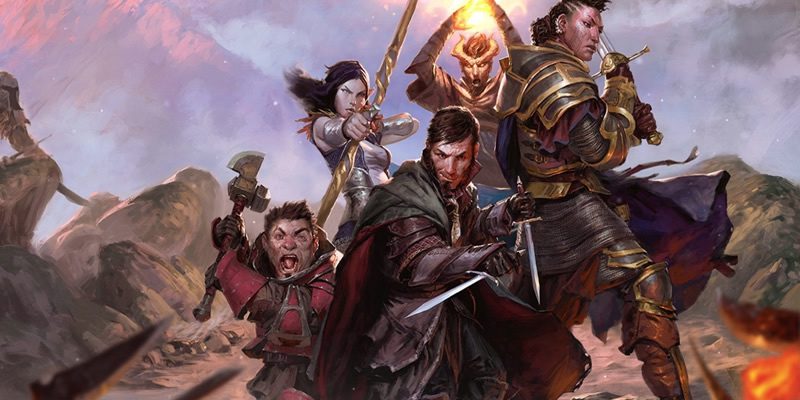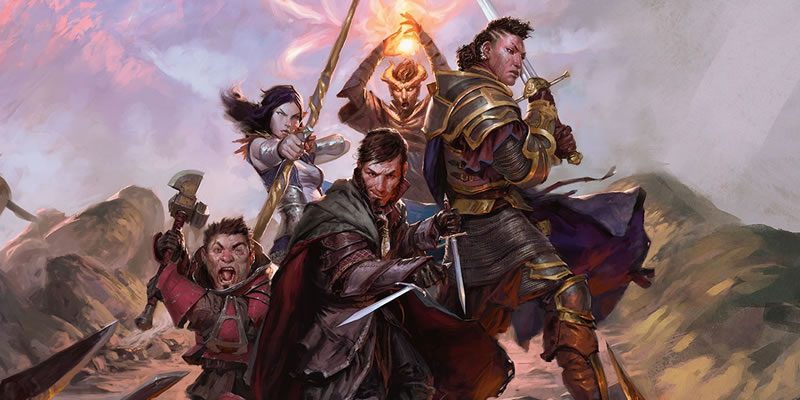The Druid Class, Part Six

Over the course of five articles on the Druid class, we’ve seen a radical shift in theme. They began as monsters, and developed into relatively staid nature-based spellcasters, dedicated to ethical principles of Balance and, perhaps, tormented into inaction by uncertainty on how to maintain it (okay, I’m guessing, but active True Neutral alignment is just So. Weird). They became nearly-feral beast-mutant (not really) Action Heroes, who rely on shapeshifting, animal companions, and the like to kick ass and take names in large quantities. The next iteration doubled down on either shapeshifting or animal companions, depending on whether you favor the Player’s Handbook 2 or the Essentials line. The shapeshifter class has, in fact, done precisely what it said on the tin, if not in the way you might have expected.
(Part One, Part Two, Part Three, Part Four, Part Five)
Fifth Edition
This brings us to the Druid of 5e. I love that the write-up of each class includes a few paragraphs of sample members of this class, often in the midst of an action scene – it’s a great shorthand for describing the class’s conceptual range, which is good because one could easily mistake the 5e Druid for being one of the narrowest classes, in terms of different concepts available. After all, about half the classes have lots more subclass options than the Druid does (two). On the other hand, much like the Barbarian, one of those subclasses includes substantial further variation, as each terrain type gets its own list of bonus spells.
I’m getting ahead of myself. The class’s basic presentation, like the rest of 5e, resembles 3.x in general terms, while many of the abilities granted go back to OD&D. Wild Shape is the most notable of these – you can Wild Shape twice per short or long rest, which is more uses per day, but the creatures you’re allowed to Wild Shape into are much closer to the “one reptile, one bird, one mammal” structure of OD&D through 2e. The function of Wild Shape is my big complaint with 5e’s Druids, so I’ll come back to it when I get to Circle of the Moon druids.
The weird thing about the Druid is that other than spellcasting, occasional improvements to Wild Shape, and Ability Score Improvements, the core class does not gain any class features between third and seventeenth level. All of the distinguishing features are shifted onto the subclasses, which is kind of unusual. It’s starkly empty of other features, though the Sorcerer and Warlock come pretty close. It allows the designers to present two almost-completely-different Druid classes.
At the top end, there are three new features that are part of the core Druid: Timeless Body, which goes back to the Unearthed Arcana Hierophant; Beast Spells, which is 3.x’s Natural Spell feat instead granted as a (surprisingly) top-end class feature – as good as sealing the promise that they won’t offer that functionality as a feat; and Archdruid, which turns your two Wild Shapes per short rest to a little sideways figure-8 guy.
Without a whole lot of class abilities to talk about, let’s look into class features. The Druid’s Hit Die is the same d8 it’s been since 1e, their armor and weapon proficiencies are the same traditional list (which means that unless they can find dragonscale armor or the like, they’re never advancing past Hide armor), proficiency in the herbalism kit, and two skills from a pretty solid list of options. Intelligence and Wisdom as saving throws is a little unexpected – matching Wizards rather than Clerics for saving throws carries the barest hint of a theme, but considering that I’m always looking for excuses to interpret Druids as a midpoint between Wizards and Clerics, I’ll take it.
Their spell list reveals the class’s major weakness. They have a lot of the same spells they’ve had in 1e, 2e, and 3.x, including a lot of melee-range spells like flame blade and melee-friendly spells like barkskin. What they don’t have is proficiency with Constitution saving throws, which they’ll be rolling a lot if they mix it up in melee – barkskin, flame blade, and lots of others have a Concentration duration. Obviously they can take the Resilient and War Caster feats just like anyone, but one might hope to see a class ability to improve their Concentration, as with the Abjurer’s Arcane Ward (damage absorbed by the Ward does not trigger a Concentration check) or the Conjurer’s Focused Conjuration (damage does not disrupt Concentration). Druids aren’t the Poké Ball launchers that their 3.x counterparts are, but they still have almost as many conjure spells as a Wizard.
They don’t have quite the variety of healing spells that a Cleric does, but once you have cure wounds, healing word, some way to raise the dead (though I don’t blame people who decline reincarnate) and both of the restoration spells, everything else is just a bonus. Druids are viable primary healers, though no one is as good at this as Life Domain Clerics – Preserve Life is simply outstanding. I do think there’s a little bit of a missed opportunity – there could be other healing spells that are uniquely Druidic (reincarnate doesn’t really count here), as there are a few healing spells that are uniquely Clerical, such as prayer of healing and mass heal. Oh well, it’s not that important.
On the whole, the Druid spell list covers all the bases – direct damage, damage over time, area control and terrain manipulation, debuffs, healing, protection, conjuration, divination… In some cases they lack the tools for very specific jobs, such as banishment, but they can still ruin a demon’s day.
So about the subclasses. The Circle of the Land is the humanoid-form (well, until there are centaurs or whatever) Druid. The Druid who does her best work with opposable thumbs, anyway. They are superior spellcasters, receiving bonus cantrips, spell recovery identical to Arcane Recovery, and additional prepared spells, some of which are lifted from other class lists. They also get some of the other class abilities we saw back in 1e and 2e. Land’s Stride ignores natural difficult terrain and grants some resistance to magically-manipulated plants. Nature’s Ward is… actually even better than the old immunity to fey charms, because now it also works against elementals, the frightened effect, and all poisons and diseases. I hate immunities so much. Thematically, why the hell should Druids be immune to harm? Advantage on saving throws would have absolutely been enough. Finally, Nature’s Sanctuary is a detaunt against beasts and plants, which is pretty cool – plants and beasts simply treat the Druid as if she had a sanctuary effect at all times.
The Circle of the Land Druid, then, looks back quite clearly to 2e and prior. These druids mostly stay in their native forms, as their Wild Shaping doesn’t offer significant combat ability. They can play a lot like Wizards who heal and call it a day; if you’re like me and think that spell acquisition is fun, try a campaign where Druids practice the same spell acquisition as Wizards and invite me to play OMG.
I digress. The Circle of the Moon Druid is quite a contrast, as they have much more in common with the 4e Druid… but even less reason to leave their Wild Shape. I have some serious problems with the design of this subclass, all centered around how Wild Shape works in 5e. For all flavors of druid, your Wild Shape duration is measured in hit points; once you take enough damage to lose those hit points, the Wild Shape is gone, and any excess damage carries over to the druid. While in the Wild Shape, the druid retains his normal Int, Wis, Cha, and proficiencies, and may gain additional proficiencies. The druid loses access to most kinds of gear (though some few kinds of gear can continue to function) and loses the power of speech and spellcasting, and gains the movement, senses, physical stats (including attacks and AC) and hit points of the new form.
I’m disappointed in this setup for a number of reasons. Firstly, it doesn’t reflect how skinchanging works in fantasy I’ve ever seen. If someone has shapeshifted into a bird and takes a tiny bit of damage, the shapeshifter doesn’t plummet to his demise; nor do Wart and Merlin worry about taking an injury and drowning while they’re swimming around the moat. Obviously skinchanging can’t really be simulated, but the goal of the rules should at least point in the direction of how the concept works in fantasy. A druid in bear form shouldn’t be forced back into her normal form as the fight heats up.
Secondly, the mass of extra hit points that Circle of the Moon druids receive in their combat forms is pretty obnoxious. An extra 127 hit points (from the form of the mammoth) gives the druid a sum total of hit points much greater than any fighter or barbarian of the same level, though at a huge cost in Armor Class. Out of all the options available, the highest AC is 15, until you look to the elementals. Physical ability scores don’t help or matter either, since they get replaced when you Wild Shape; in principle you’re going to spend some combat time out of Wild Shape, but most of the time a Druid with 8s in Strength, Dex, and Con fares just as well or poorly as one with 20s in those stats. Even a 20 Wisdom isn’t all that useful (except for saving throws), if you plan to Wild Shape and burn all of your spell slots for self-healing.
Thirdly, there’s the other side of the hit point thing. While Wild Shaped, the druid does not have her native hit point total. Think of those hit points as RFG‘ed, though any damage in excess of the Wild Shape’s hit points do carry over to the druid as they change back. This means that even at 20th level, as a triceratops, you have 95 hit points – and as a hawk, you have 1. No big deal, right? You can just fall back on your hit point pool when you take damage. But no! 5e has these hit point threshold rules ready and waiting to bite you in the ass. With 1 hit point, a 20th level druid shapeshifted into a hawk is susceptible to a first-level wizard casting sleep. That one is a trifle absurd, so let’s try a more likely case: a 20th level druid is shapeshifted into a triceratops for a fight. This is a pretty good idea! But with only 127 hit points, the druid gets no saving throw when the bad guy whips out power word: stun (the mammoth and the elementals are the only Wild Shapes available that aren’t subject to Kill).
Lastly, it drives me a little bit crazy to see a class that doesn’t need anything. Look, the Vow of Poverty in the Book of Exalted Deeds and the Oathsworn class in Arcana Evolved are experiments in characters that have no use for treasure. The Circle of the Moon druid is not the absolute case that the VoP and Oathsworn are, so the druid can gather all kinds of stuff to improve combat ability in humanoid form. (Here I’m ignoring stuff to improve non-combat ability, as such magic items are rare. Also, the druid’s favored non-combat functions, travel and perception, are enhanced rather than diminished by wild shaping.) My point here is that D&D needs players to want things. Yes, you want players to care about goals other than treasure – the plot of the game, their social and political goals, and so on. Seriously, I know. You also want material rewards. D&D can still be D&D without any loot at all, though I feel kind of bad for the Fighters, Rogues, and Wizards of such a campaign. Especially the rogues, who lose their class abilities without their weekly filthy-lucre bath. Won’t someone think of the Rogues?
The Circle of the Moon Druid’s other features enhance their Wild Shaping – they can spend spell slots to heal without leaving their beast form, they can Wild Shape as a bonus action rather than an action (a clear mechanical nod to 4e – that was the specific source of the fluidity of form I liked so much), a change to the CR limits on what you can Wild Shape into, scaling up to CR 6 at 18th level. The Monster Manual list of beasts at the higher CRs is awfully slim – CR 6 has only the mammoth – so I hope they’ll release a few more high-CR beasts in the future. Maybe the game treats a legendary tiger (we’ll call him Shere Khan) as a CR 6 beast whose form (well, size mainly) you can assume. Their natural weapons count as magical at 6th level, at 10th level they can take on elemental forms by spending both of their Wild Shape uses (oh, hey, a Wild Shape with an AC of 17, and all elementals have resistance to nonmagical damage and a boat of condition immunities), and at 14th level they can alter self at-will. I do like that there are a small number of Beasts that are not just real-world creatures or giant versions thereof, but I’d like to see a few more options, to give the Druid more situational adaptability and encourage them to change from one very useful form to another – Monstrosities like the Displacer Beast and the Death Dog should be relatively okay for use.
What we have, then, is a Druid who really shouldn’t be the party’s primary healer, and if they can help it not even a secondary healer. In fact, try to treat them as if they aren’t spellcasters at all. Think of them as fighter-types that lose and regain hit points even more often than normal meat shields, since they have a lower AC but a ton of spell slots that don’t need to do anything but self-heal. It is as total a contrast from the Circle of the Land Druid as one could want.
This brings us to the end of this series on the Druid class, for the time being. I hope you’ve enjoyed it as much as I have! From its OD&D origins as a monster type, it became a nature priest. From there it became a master multitasker, dominating the action economy (and implicitly changing all future development as it taught the importance of the action economy). In 4e it diverged into two archetypes, the nature priest and the skinchanger, and that dichotomy continued forward into 5e. Looking forward to the Elemental Evil storyline, we do see Druids developing a certain degree of “nature bender” as an available concept; because of the dependence on spellcasting to communicate that theme, I’d expect it to manifest almost solely within Circle of the Land Druids.



